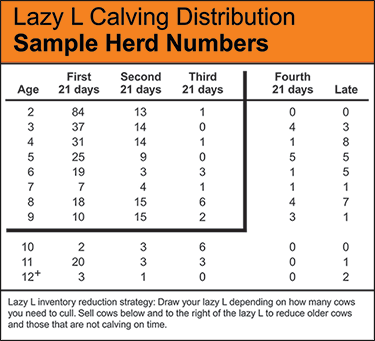
Kris Ringwall
Beef Talk
Prepare for a dry year using lazy L culling.
An example of proactive management is when a producer evaluates cow-calf numbers and determines in advance how many pairs should be turned out to grass and adjusts the inventory accordingly.
Looking at the drought forecast certainly causes concern. It's not panic, just concern. In some areas, the lack of precipitation persists, while other areas are candidates for less precipitation.
In reality, producers should be preparing for less forage availability and implementing grazing strategies that will be in balance with what Mother Nature decides to provide this year. No one will know until summer's end. However, by then, it is too late to be proactive.
For many, continued drought or low precipitation will result in feed shortages and increased costs that must be weighed against a producer's perpetual optimism. However, there are real limits to how Mother Nature deals the cards.
 One of those cards is capital, which means how much money a particular producer has to risk. Risk is a key to survival. Producers need to take some risk, but risk protection also is important. As producers take advantage of risk management programs that are offered, risk can be lowered.
One of those cards is capital, which means how much money a particular producer has to risk. Risk is a key to survival. Producers need to take some risk, but risk protection also is important. As producers take advantage of risk management programs that are offered, risk can be lowered.
Also, managing and guiding production can minimize risk. From the management side of risk, one common thread among many financial downfalls is the failure to act at the proper time. We all are faced with challenges throughout our lives, but doing nothing creates nothing. The cattle business can be a wait-and-see business. However, management should be proactive, not reactive.
Ranching and farming are like driving fast cars. Sometimes the road curves a little more than you want or the road conditions are not what you want. In either case, adjustments in speed and direction need to be made to survive. As the road narrows, the heart rate may go up, but careful planning and preparation will bring out the survival instinct and you can steer your way through. However, if you wait too long to make the needed adjustments, your car will spin out of control with possible tragic results.
Adjusting inventory is one option open to cattle producers. Keying in on bred cow sales or timing cull markets certainly can produce cash, cut costs and, we hope, bank dollars for a future day or reduce debt. Inventory reductions actually can be beneficial, particularly if a focus is maintained on the core cow herd.
For those producers who utilize the Cow Herd Appraisal and Performance Software (CHAPS) program or any producer who has calving records, the Lazy L principle should be applied. The Lazy L is a simple evaluation of the current calving season. This is a lot easier for those producers who already have a calving distribution table.
If you don't have a distribution table, here is how to draw one up. Take a sheet of paper and make five columns listing the dates when the cows calved across the top. The headings should read first 21 days, second 21 days, third 21 days, fourth 21 days and late.
Proactive management can help handle challenges, avert potential disasters.Now make a row for each age of cow you have in the herd. When you get done, you will have made a table with all your cow ages down the left-hand side and calving cycle days across the top. To complete the table, go to your calving book and mark down each cow in the appropriate box in the table.
For example, H8220 is a 4-year-old cow that calved 30 days into the calving season. Place a mark in the 3-year-old row and "second 21 days column." G7108 is a 5-year-old cow that calved 15 days into the calving season and would get marked in the 4-year-old row and "first 21 days" column.
After going through all the cows, you will have a table that shows the distribution of your calving season by cow age. Depending on how many cows you need to cull, draw a Lazy L and sell everything below and to the right of the Lazy L.
For example, the Dickinson Research Extension Center drew a line between the 9- and 10-year-old cows and a line between the third 21 days and the fourth 21 days to create our Lazy L. In a previous dry season, the center sold everything below and to the right of that Lazy L. What this does is identify the older cows, as well as those cows that are not calving on time. Many of these cows will work just fine for someone else. Also, it will clean up and fine-tune your operation.
After you get done with the Lazy L, don't forget to throw in a couple of wild, poor-mothering or poor-milking cows.
The bottom line is that reducing cattle numbers will reduce forage needs.
May you find all your ear tags.
 Your comments are always welcome at www.BeefTalk.com. For more information, contact the North Dakota Beef Cattle Improvement Association (NDBCIA) Office, 1041 State Ave., Dickinson, ND 58601, or go to www.CHAPS2000.com on the Internet.
Your comments are always welcome at www.BeefTalk.com. For more information, contact the North Dakota Beef Cattle Improvement Association (NDBCIA) Office, 1041 State Ave., Dickinson, ND 58601, or go to www.CHAPS2000.com on the Internet.










